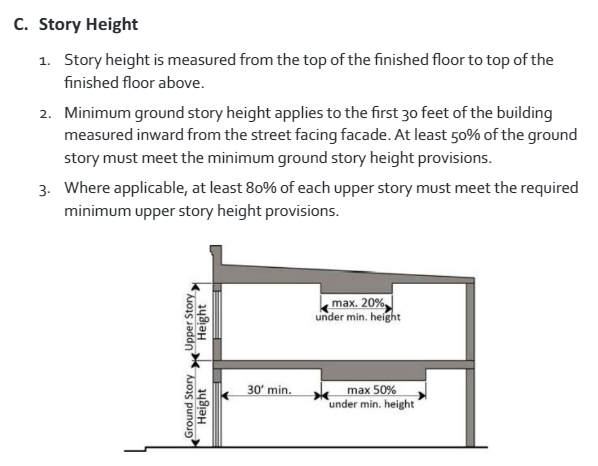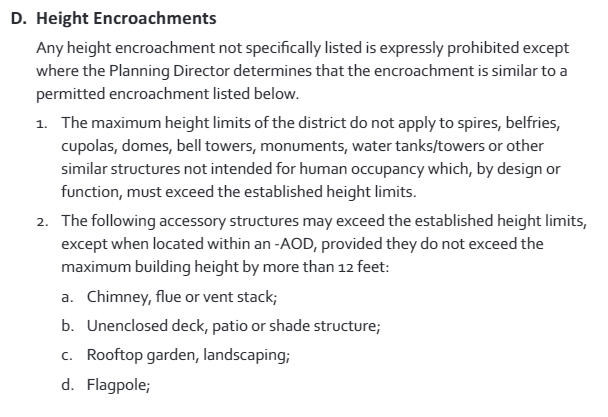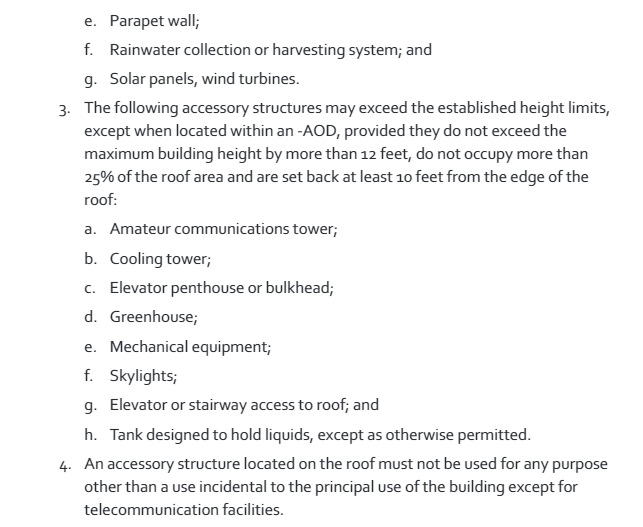City council moving forward with reviewing height changes to 3, 4, 5 story buildings. Cox made some speech about he would personally want even lower height requirements or something. He was promptly ignored and doesn’t look like he’s having a good time.
For the life of me, I don’t understand the enthusiasm for unlimited height in 3, 4 and 5 story buildings. What essentially does anyone imagine needing more than the generous heights already associated with these 3 zoning heights? Can someone give me an example of what would exceed the existing heights? Do we really want 100 foot high 3 story buildings? Give me some examples; I’m truly trying to understand why this is necessary.
Conversely, putting an unlimited height on (especially) 3 story zoning could come back to bite a lot of adjacent residents in the butt, and not just in downtown. I’m still not convinced. My mind can be changed, but I just haven’t heard any convincing argument.
It’s not for unlimited height just a few extra feet to the current limits.
Again, what’s the need?
50 feet over 3 floors is nearly 17 ft. per floor.
Also, when you say unlimited, then you aren’t just saying a few extra feet, you are literally giving a blank check to height.
But are you the only one saying unlimited?
When you take off the height restriction, there is no limit.
Doesn’t impact single family homes since those are typically zoned R-2, R-4, R-6, R-10 where the number refers to units per acre. Would have to be zoned RX-3, RX-5, NX-3, NX-5, etc…
Don’t really see this having a huge impact as compared to the previously approved height changes for the other zonings. Could be they are just trying to stay consistent?
It impacts single family homes when they sit next to a NX3, etc. zoning that’s supposed to be a transition zoning to their single family neighborhood.
Oh I gotcha, yea. But as you’ve calculated, it doesn’t really make sense for a developer to build super tall floor heights. Doubt this has a huge impact.
Well, if what’s being proposed at the corner of Peace and Boylan is any indication of what could happen, I think that giving an unlimited height invites abuse. The rezoning of that property was set at 4 floors, yet the proposals being seen now count as five floors when you look at the elevations. How? Well, I am not sure exactly, but it’s easy to imagine that the developer is calling the 5th floor a mezzanine or something, or arguing that it’s not another floor to the building. I can see that happening with a proposed 3 story building as well.
I still want to understand what type of 3 story building within current zoning can’t be accomplished in 50 feet. I want to understand some examples. I haven’t seen any yet.
@John From what I got hearing the discussions during the committee meetings on this topic, I took it that the current height for a 3-story building (for example) is more difficult to make work because today there are lots of needs in the ceiling. Not sure of the blanket term for this stuff, someone help me out, but I’m talking about the HVAC, the fire sprinklers, running cables for power and ethernet. That kind of stuff.
If we use building heights during a time when these modern things weren’t envisioned then today, you can’t get those things in there without being really creative. (and therefore spending more money)
I’m particularly interested in this because I feel like it would be one more step to seeing development in the 3,4,5,7 story area to fill in the gaps in downtown, for example on Hargett Street seen here:
This may not apply to all areas zoned mixed-use but I do think it important enough for the core downtown, even the historic downtown as I mention above.
And just to be clear, I’m not advocating for unlimited height. I just think it reasonable to consider a few more feet if in fact it’s determined that our building heights are a hindrance to development here because of what I mention above.
Thanks for your summary Leo. It’s much appreciated. It’s always reasonable to consider, and that’s what I am trying to do.
That said, the 50 feet for a 3 story building is plenty of space to do above the ceiling what needs to be done in an all-commercial application. Of course, if a developer wants extremely tall ceilings in their space, it would require more, but that’s not typical since extra tall space costs a lot more to build, and a monumental first floor on just a 3 story commercial building is highly unlikely. Plus, 3 story commercial buildings are getting rather passe now with the rising costs of land, and are more likely far flung suburban buildings because of that.
That takes us to mixed use buildings where the first floor is concrete for retail/services and the subsequent floors are residential, hotel, etc. Let’s say that there is a desire to have monumental space of 20 feet on the first floor then an 8 inch concrete slab, and then two floors of residential above it that are wood framed. Even if we consider tall floor to floor height of 12 feet (more likely closer to 10), you still don’t need 50 total feet.
Maybe this request is tied to how we measure height? If a facade is on a slope, and adds 10 feet to the measured height because the property slopes from one side to the other and that 10 feet is just filling the space between the sidewalk and the first floor, then that would be a compelling argument to discuss how height is measured on a facade. I’d rather see that adjusted than offer a blank check for height.
Finally, I’d like to see someone show me a section of a proposed building that demonstrates a burden on a developer because they are only allowed 50 feet for a 3 story building.
Quick question: Does the UDO measure to the roof height, not a parapet wall?
For 117 E Hargett (per your street view), I’d love to know how tall the buildings are to the left and right of that gap.
Don’t know if I’d call it a blanket term, but you can say MEP (mechanical, electrical, plumbing).
I’ve heard “plenum space” as well.
A Chase is an architectural term for a space to be used by HVAC ductwork and flue pipes that don’t fit in a typical wall or floor assembly
Or you can just call it the plenum. Either way, it’s where MEP services are managed horizontally in a building.
Thanks. So, in effect, the height of the buildings is basically measured to the roof.


